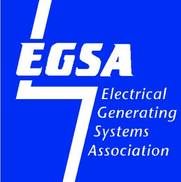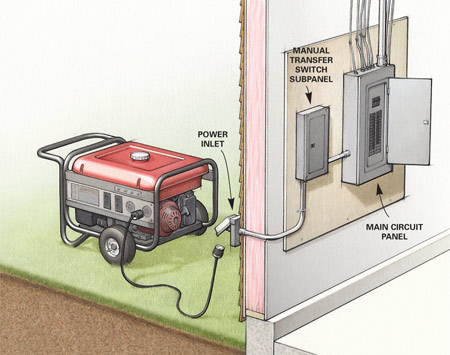Standby Generators
A
standby generator is usually and permanently installed outside your
residence or commercial building and wired directly into your
electrical system. It is used to provide power to some or all of
your circuits during a disruption of utility power. Standby
generators can be fueled by liquid propane, natural gas or diesel
and usually start effortlessly and
automatically.
A
standby generator may cost as little as $2,900 or as much as
$15,000 or more--the greater the power capacity, the higher the
cost. Additional installation costs also apply to your specific
system. Standby generators create from 7,000 to 25,000 watts or
more of power. You'll have to choose a standby generator that
supplies sufficient peak and continuous wattage for the circuits or
appliances you need to power.
Portable
Generators
Portable power
generators are versatile and used for:
• emergency power at
home
• power in remote locations where
utility power is unavailable or
• recreational purposes, like
boating or camping
Portables can be fueled by gasoline,
liquid propane or diesel and include 120-volt power outlets like
the ones in the walls of your home. When the generator is running,
you can plug appliances and tools directly into these outlets. Some
generators also include 240-volt outlets (that is, the kind of
outlet for an electric dryer or for other large
appliances).
Portable power systems can
range from $1,500 to $3,900 depending on wattage and require
manual starting. Manual transfer switches can also give you the
ability to connect a portable generator to your permanent
electrical system. You can choose the circuits or equipment that
you need to power based on the generator's capacity.
What is the best generator for the money? The installation costs of
portable generators are usually less than that of standby. Factors
such as manual activation and fueling are required to keep the
portable system functioning during an
emergency/outage.
Standby Generator
Maintenance Checklist
Here’s a handy
checklist to help guide you as you work to maintain your standby
generator(s). Be sure to take note of the frequency recommendations
for these maintenance activities.
Weekly
Maintenance
- Run the generator (typically no-load, automatic transfer
switch exercise cycle).
- Verify that the unit ran and has no alarms or
warnings.
- Ensure adequate fuel levels.
- Ensure that the generator is in “Auto” mode, for
automatic startup.
- Check that the circuit breaker is closed.
- Make sure there are no fluid leaks.
Monthly
Maintenance
- Check engine coolant level.
- Check engine oil level.
- Check the battery charger.
Bi-Annual
Maintenance (Schedule maintenance with a certified
technician.)
- Inspect the enclosure.
- Check the battery electrolyte level and specific
gravity.
- Check battery cables and connections.
- Inspect drive belts.
- Inspect the coolant heater.
- Check coolant lines and connections.
- Check for oil leaks and inspect lubrication system hoses
and connectors.
- Check for fuel leaks and inspect fuel system hoses and
connectors.
- Inspect the exhaust system, muffler and exhaust
pipe.
- Check and clean air cleaner units.
- Inspect air induction piping and connections.
- Inspect the DC electrical system, control panel and
accessories.
- Inspect the AC wiring and accessories.
Annual
Maintenance (Schedule maintenance with a certified
technician.)
- Change oil and filter.
- Change the fuel filter.
- Change the air filter.
- Clean the crankcase breather.
- Change spark plugs.
- Check coolant concentration.
- Flush the cooling system (as needed).
- Perform load bank testing.
- Fuel testing & reconditioning (diesel-fueled units
only).
- Remove water from fuel tank (diesel-fueled units
only).



